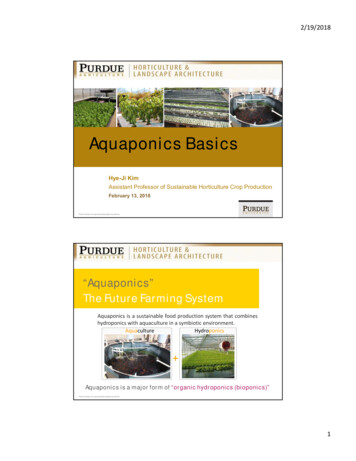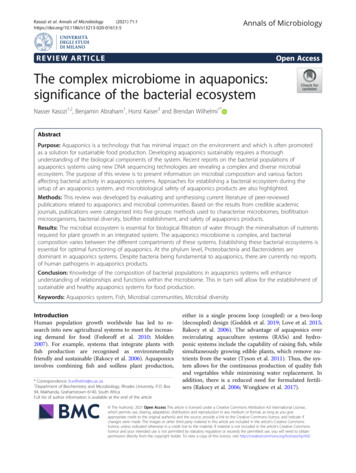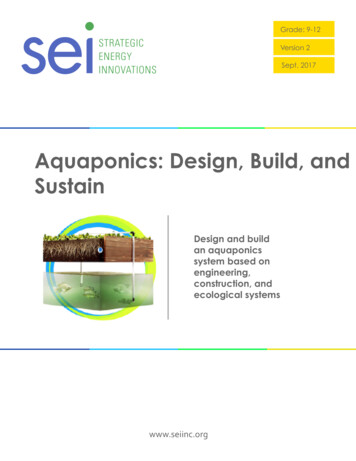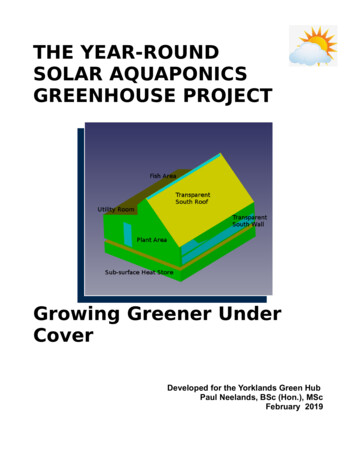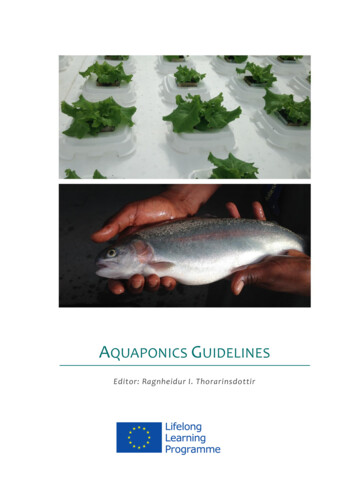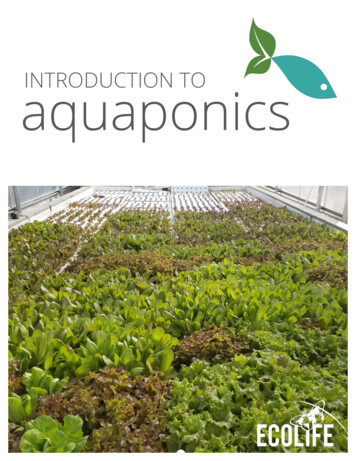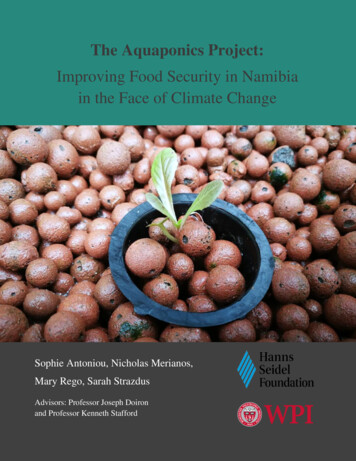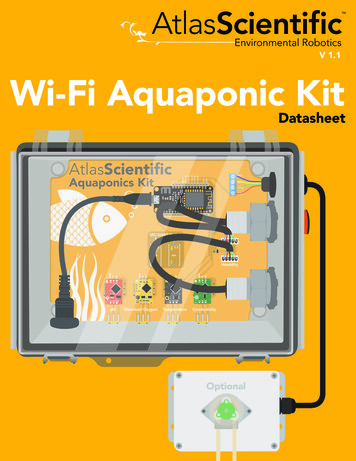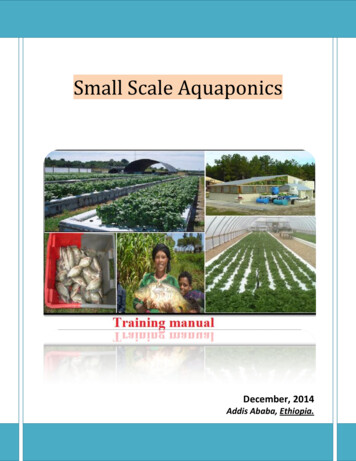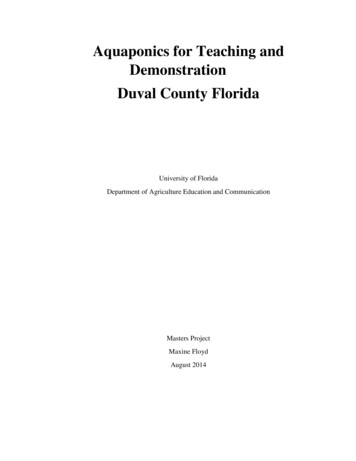
Transcription
Aquaponics for Teaching andDemonstrationDuval County FloridaUniversity of FloridaDepartment of Agriculture Education and CommunicationMasters ProjectMaxine FloydAugust 2014
Table of ContentsIntroduction 3Teachers as adult learners . 4Purpose and Objectives . 5Definition of Terms and Acronyms 5Limitations of the Study . 6Basic Assumptions . 6Significance of Problem . 6Theoretical Framework . 7Methods . 8Population and Sample 8Research Design . 9Training Description 9Course/ Workshop Understandings . 11Essential Questions . 12Cornerstone Tasks 12Assessment and Evaluation . 13Results . 20Conclusions . 12References 22Appendix . 26
Introduction:School gardens have become extremely popular within the United States in recent years.Gardens are a wonderful tool to teach youth responsibility, promote healthy eating, and buildself-esteem and confidence, (Story, 2009). Students in public schools come from very diversebackgrounds; gardening can increase communication and build common interpersonalrelationships. These gardens can consist of raised bed or container gardens, traditional in groundgardens, hydroponics, and aquaponics. Aquaponics is a technique that combines hydroponicgardening and aquaculture and can be used as an education tool in many disciplines, allowingstudents to learn through experience. Aquaponic systems are a fun way to incorporate educationon local food systems and environmental sustainable practices into the science classroom.Recirculating aquaponic systems use much less water than traditional in-ground farming. Thefollowing program uses miniature aquaponic and barrel aquaponic systems as a teaching tool forstudents to learn science, math, engineering, and technology. This system is small enough to beset up in any classroom setting to teach adults (teachers and youth volunteers) and youth plantgrowing techniques, water quality, the nitrogen cycle, aquaculture techniques and recyclingpractices, while increasing awareness of environmental issues facing Florida. The program canbe used as presented or modified to suit the needs of your classroom setting.Aquaponic systems in science classrooms can be invaluable education tools, allowingstudents to learn aquaculture, horticulture and sustainability. Hands-on activities provide studentswith an opportunity to experience what they are learning. Experiential learning opportunitieswith aquaponic systems lead to increased knowledge retention, promote positive behaviorchange, and increase appreciation and awareness of fresh, locally grown food, which increasesparticipation in local food systems and awareness of food security. Adults and youth exposed to
educational activities using sustainable practices are more likely to adopt environmentallyfriendly practices and have greater appreciation and awareness for local food systems.The Duval County Extension Office has designed this program to prepare students,teachers, and youth leaders techniques to build their own aquaponic systems and engage studentsin STEM curricula. By incorporating aquaponics into daily classroom activities teachers canincrease nutrition education opportunities and address childhood obesity. Aquaponic systems canbe expensive and time-consuming, but this program shows participants how to build aninexpensive and user-friendly system which will produce plants and fish simultaneously.Teachers as Adult LearnersThe program participants in the “Aquaponics for Teaching and Demonstration” workshopconsisted mostly of public school teachers and master gardener volunteers. Knowles (1980)explains that there are four basic assumptions associated with the adult learning theory. First,adults are competency based learners in that they would like to apply new skills and knowledgeto their current situation. Second, adults usually have many experiences that they can relate newknowledge too and use as a resource for learning. Next, adults have specific learning needs basedon real life problems or situations; lastly, adults become more self-directed as they mature. Manyteachers have little or no budget, but have tons of creativity; therefore, by providing participantswith the knowledge resources to build an aquaponic system they can put their limited resourcesto best use. Merriam (1999) states it is important to recognize and acknowledge the previousknowledge and experiences of adult learners, including their ability to recognize their own skillsas lifelong learners. Teachers are looking for opportunities and unique projects to engage theirstudents while also providing them with life skills. While, providing the background knowledge
to enable these adult learners to build their own aquaponic systems, it is important toacknowledge the differences among individuals, their backgrounds and learning styles.Purpose and ObjectivesObjectives: Two objectives of the Aquaponics for Teaching and Demonstration Program are toprovide teachers, master gardeners and volunteer leaders with clear instructions to build theirown aquaponics system using primarily recycled materials and provide supportive materials forsystem maintenance and education materials for incorporation into classroom curricula.Definition of Terms and AcronymsAquaponics- a system of aquaculture in which waste produced by fish or an aquatic speciesprovides nutrients for hydroponically grown plants which assist in cleaning the water ammoniaand nitrogen from the system.Hydroponics- the process of growing plants in a soilless environment.IFAS- Institute of Food and Agricultural Sciences; a federal, state and county partnershipestablished to increase knowledge in agriculture, natural resources, and life sciences to improvequality of life for individuals.STEM Education- Science, Technology, Engineering, and Math; an approach to teaching andlearning that integrates the content and skills of science, technology, engineering, andmathematics. These behaviors include engagement in inquiry, logical reasoning, collaboration,and investigation. The goal of STEM education is to prepare students for post-secondaryeducation and the workforce.Sustainability- using methods that do not deplete natural resources.
Limitations of the StudyLimitations of this research include:1. The study was limited to participants in Duval County Florida in the Northeast region ofthe University of Florida Extension District.2. Participants may have certain characteristics that may predispose them to specificoutcomes (experience, education).3. Participants may not answer all answer all of the questions on the assessment orevaluation.Basic Assumptions1. All participants will understand evaluation instruments and will not be misled.2. Participants will answer survey instruments honestly.Significance of ProblemAquaponics for Teaching and Demonstration provides simple examples of aquaponicsystems that are inexpensive to build and require little previous knowledge to successfully growplants and aquatic species. Teachers and homeowners frequently spend large amounts of moneyon systems that are not designed for small spaces and require large amounts of maintenance andcare. The content taught in this workshop provides background knowledge to successfullyestablish and maintain a new aquaria-ponic or barrel-ponic system in a classroom or backyardenvironment. Safety is another significant portion of this training; first, it is essential whenworking with students to ensure physical hazards do not exist (tripping, cuts or electricity), andsecondly, food safety (proper hand washing, harvesting, and processing techniques). It isimportant for educators, students and volunteers to have a positive experience and success when
establishing a new system to create a positive learning environment and provide motivation tocontinue sustaining the aquaponic system.This workshop also provides a new creative method for teachers to engage students in theclassroom through experiential learning. By using STEM education, students are provided handson experience that will assist them in gaining life skills as well as obtain a deeper comprehensionand application of science, math, and engineering content.Theoretical FrameworkKnowles’ (1980) Adult Learning Theory states adults learn from their experiences, newinformation must be significant to their current situation, and real life issues generate the need tolearn new information. Teachers are in a constant search for new curricula and activities toengage their students, while still meeting state and national standards. Aquaponics for Teachingand Demonstration fits this need by providing a flexible list of activities, readymade curriculasources, and an easily constructed, real- life aquaculture production system. The adult learningtheory is based on problems not content; and with aquaponics there are a multitude of issues thatcan be simplified through training.The adult learning theory also blends well with the constructivist approach is a learningtheory that draws from the students existing knowledge, beliefs and skills. “Constructivismcontends that students are not sponges ready to absorb and use transmitted knowledge; theknowledge already written on their mental slates affects how they interpret new observations andhow they accommodate newly constructed knowledge. If, during the course of instruction,teachers are not cognizant of students’ prior knowledge, then the message offered by the teacherlikely will not be the message constructed by the student” (Mestre 1991).
MethodsThe program uses a miniature aquaponic system as a tool to enhance students’ experiencein science, technology, engineering and math. The model system is small enough to be set up inany classroom setting, can be built with little cost, and can easily be assembled anddisassembled. It can be used to teach plant growing techniques, the nitrogen cycle, aquaculturetechniques and recycling practices, while increasing awareness of environmental issues facingFlorida. Participants gain knowledge on basic principles of aquaponics, Florida rules andregulations, and instructions for constructing a small aquaponics system. The workshop providesinformation on types of aquaponic systems and how to construct them; water qualityconsiderations for plants and fish; basic fish health care; food safety considerations, and currentcurricula available.Topics also include information on successfully plant and aquatic species for specificsystems, plant growing techniques, the nitrogen cycle, aquaculture techniques and recyclingpractices, rules and regulations, while increasing awareness of current environmental issuesfacing Florida. Participants will receive lesson plans to be used in the classroom, aquatic systemrequirements and design, information on food safety and hygiene, plant selection and nutrientrequirements, and an introduction to fish nutrition and health. Participants also have theopportunity to participate in modeling exercises demonstrating how an aquaponics system works.Population and SampleThe population for this study included Duval County Public School teachers andvolunteers of the University of Florida Duval County Extension Office. The workshop occurredin June of 2014 at the Duval County Extension Office. The program was posted and advertised
though email list serves through the Duval County Extension Office and the Duval CountyPublic Schools. There were approximately 45 teachers and volunteers that attended the training.Class sizes generally range between 15 and 50 participants; however, because of the restrictedschedule of the Duval County Public School teachers, the participant registration was set for onesession during their break from classes.Research DesignThis study used quantitative research techniques and was administered via a pre andposttest. The assessment tool consist of a multiple choice pre and post and the evaluationinstrument utilized a Likert scale that can be statistically analyzed. The survey instrument wascreated, pilot tested and revised by the research to ensure validity and reliability. The pre-testevaluation was provided at the beginning of the workshop during the registration period and wascollected prior to introduction of workshop materials. Participants provided their name (or coulduse a fictitious name to provide anonymity) on both the pre and posttest to enable the researcherto compare and evaluate knowledge gain.A follow up evaluation will also be sent out six months from the date of the workshop toevaluate the implementation of new systems and environmentally friendly gardening procedures.Training DescriptionThe Aquaponics for Teaching and Demonstration workshop provides participants withknowledge to build and implement an aquariaponic or barrel-ponic system in their classroom.The materials presented will off teachers the basic knowledge and skills to startup a simpleaquaponic system and create a sustainable environmentally friendly experiential learningopportunity for their students. The program was designed to cover the most essential components
of system design, water quality, fish health, food safety, and available K-12 educational curriculato meet Next Generation Science Standards and Common Core Standards.The workshop is designed to assist teachers that are interested in building or are currentlyusing an aquaponics system for purposes of teaching K-12 students STEM, agriculture,horticulture, and nutrition education. These systems can be simple and inexpensive or elaborateand extremely costly. The purpose of the workshop is to provide background knowledge andresources to assist Duval County Public School’s teaching faculty with the needed resources tosuccessfully rear and harvest aquatic species and vegetable crops simultaneously with fewresources and little space.There are four broad subject areas that are covered, aquaculture, horticulture, food safetyand educational curricula. Aquaculture encompasses many different species, types of equipment,and techniques. The rationale behind this module is to break this broad spectrum industry into asuitable, user friendly, applicable teaching tool for K-12 teachers. There are several primaryconcerns, first and foremost human safety; followed closely by animal welfare and life support.Safety concerns in the classroom can stem from the combination of water, electricity, movingparts, tripping hazards, and biological concerns (bacterial or fungal infections). Life support andanimal welfare is where most people fail in aquaculture. There are many factors that lead intolife threatening hazards for fish and aquatic species, and many of these can occur quickly. Unlikemany animal species that may be alright if left in a dirty cage over a weekend, a fish’senvironment or tank provides them all of their life support including oxygen (fish breathe too!).The fish’s gills filter everything that enters its body (good and bad), and this is where theimportance of water quality measurements, filtration, equipment, and the nitrogen cycle areessential for success.
Next, horticulture is the process of growing plants for human use; this is limitless as towhat plants, techniques, or environments this includes. For purposes of this workshop, we willspecifically focus on growing plants in aquatic environments. Note that this course will onlydiscuss fresh water systems; however, salt water environments are also suitable, the equipmentand processes are nearly identical; salt water systems function well as part of environmentalscience or habitat restoration projects. Because this workshop focuses on the use of aquaticsystems to grow plants, it is necessary to determine what plant types will thrive in thisenvironment, when to plant them and how to determine when they should be harvested. Alongwith general plant knowledge, it is important to understand the risks involved both as a teachingprofessional and to students. Food safety is a huge concern if growing edible crops. Lastly, thereare many gardening curricula available; therefore there is no need to write custom curricula inmost cases. The final task will include identifying the sources of current curricula and how toadapt them into fitting lesson plans for your school district.Course/ Workshop UnderstandingsLearners will understand that:1. Aquaponics is a great method to incorporate biotechnology into today’sclassroom environment.2. School gardens are a wonderful teaching tool for any subject area.3. Educational curricula are available for any grade level.4. There are regulations through FWC on certain species of fish.5. The most important factors in successful aquaponic systems are water quality
and stocking density.Essential Questions1. What is aquaponics?Objective 1: Describe system requirementsObjective 2: Review plants that will work well in small systems2. What are the major concerns with water quality?Objective 1: Nitrogen cycle and stocking densityObjective 2: Alkalinity, chlorine and dissolved oxygen3. Why is fish health important?Objective 1: Describe normal fish behavior and signsObjective 2: Fish diseases4. Why is food safety important?Objective 1: Important bacterial, fungal and viral infectionsObjective 2: Preventative management5. How do I incorporate aquaponics into my classroom?Objective 1: Aquaculture and aquaponics curriculaObjective 2: Agriculture and gardening curriculaCornerstone Tasks1. General principles of aquaculture:Assist participants in understanding the importance of water quality; participants willmeasure several water samples and identify problematic parameters and their potential causes.
Participants will learn how to calculate fish stocking density for various scenarios. Individualswill learn permitting requirements for their County and which regulatory district your county isin; this will also cover USDA annual inspections.2. Growing seasons and horticulture:Teach participants how to select the best plants for their system, determine whenvegetables will grow, how long it takes to harvest, and nutritional requirements coming from theaquaculture system. Participants will also review the water cycle and the importance of thenitrogen cycle in Aquaponics system to both the fish and plants.Assessment and EvaluationThis workshop will use a multiple choice pre and posttest format to determine ifparticipants have improved their knowledge base. A six month follow up survey using a Likertscale will also be conducted to evaluate the long term success of applicable knowledge ofaquaponic system use in the classroom. The data collection process will be concluded on June16, 2014. At this time, pre and posttest data will have already been tabulated and the survey datawill be obtained in January 2015. From this point a quantitative analysis will be performed andthe summative evaluation compiled. The evaluation will include demographic information onparticipants, pre and post knowledge based questionnaire answer, and then data from the followup survey to analyze how the workshop participants implemented the materials. At thecompletion of the evaluation a complete cost analysis and return on investment will be availableto plan for future workshops. The program evaluation will be made available in the extensionoffice’s annual report and will also be shared with stakeholders that may be interested receivingtraining, providing future support or providing training or materials to assist teachers in future
workshops. These stakeholders will include the Florida Department of Agriculture, CountySchool Boards and City commissioners, and corporations such as Verti-Gro, Black Cow, andPentair.The Aquaponics for Teaching and Demonstration training will use Stufflebeam’s CIPPEvaluation Model. CIPP stands for context, input, process, and product, all of which are differenttypes of evaluation but can be used together. One of the largest challenges to using aquaponics ina school environment are logistics, tight teaching schedules, and readymade curricula. Mostteachers’ look at aquaponic and hydroponic systems as expensive and complex, but there aremany ways to build a system that is neither.Next, input will be evaluated by looking at available resources. There are many availableresources for startup and maintenance of any type of school garden. These can includegovernment grants from the US Department of Agriculture or Florida Department of Agricultureand Consumer Services or other government agencies. Input can include donation of materialsfrom Home Depot, other local hardware stores, or plant and soil companies. Lastly, there areunlimited numbers of third party companies and non-profit organizations that are happy to assistwith materials, cost and often labor at schools. The only input that may not be easy to fix atspecific schools is a place to put a large aquaponic system. Often, there are ways to downsize tomake it more reasonable for the area available; but there are rare occasions where there is simplynot an appropriate or safe space to implement an aquaponics system on school grounds.Process is the third part of our evaluation tool. This will include how the knowledgegained at the Teacher’s Guide to Aquaponics is implemented. This refers to teachers who havemade improvements to existing systems at their school, teachers who have built (or attempted tobuild) new systems, and teachers that do not have the commitment to build a full size system but
have scaled it back to allow the students design a model system similar to the activity in theworkshop. This part of the evaluation will be exceptionally usefully for planning futureworkshops and ensuring that they fit the needs of a wide spread versatile teacher audience. If theworkshop concludes and teachers do not take the processes back to their classrooms there maynot be a demand for the program in the future.The last part of Stufflebeam’s model is the product evaluation. For this initial workshop, Iwould like to 1) evaluate the effectiveness, cost, and logistics of the aquaponics model thatteachers put together in the workshop; and 2) evaluate the cost effectiveness and return oninvestment of the workshop as a whole. This component of the CIPP model is the equivalent of asummative evaluation and therefore will be conducted from the beginning until the end. This isan important evaluation process because it examines all of the previous variables as well as theend product. For this process to be complete, it is important to look at the needs assessment, theentire environment, the funding sources and other resources, the processes that were followedand implemented, and the finished product.By using Stufflebeam’s CIPP model, you can complete formative and summativeevaluations nearly simultaneously or the formative leads to the summative evaluation. This isuseful in many cases, such as this teacher workshop. It is specifically useful because there isalways room for improvement, and by using a formative evaluation from the beginning of theprogram you can easily make the needed improvements while planning for the next step. It isalways necessary to evaluate the program itself and its objectives; without this information youmay be teaching the right information to the wrong audience or the wrong information to theappropriate audience. For purposes of this workshop, the primary objective is to enable teachersto design their own aquatic systems without being concerned with spending thousands of dollars,
and empowering them with the basic knowledge to keep their students safe, and aquatic plantsand animals alive. This may seem simple, but it only takes a few small things to go wrong andthey compound into large problems equating to a major headache for an already busy teacher.This workshop is also intended to assist teacher in implementing new engineering practices tomeet the Next Generation Science Standards without having to write their own curricula. Theimplementation of the Next Generation Science Standards is coming within the next two years tobe fitted into the Common Core Standards which began this year. NGSS will be focused onSTEM education, encouraging all lessons to use Science Technology Engineering andMathematics regardless of the subject area.The assessment and evaluation instruments are as follows:Aquaponics for Teaching and DemonstrationPre/ Posttest for June 16, 20141. What is the proper stocking density for fish in an aquaponic system?a. 2 fish per gallon of waterb. 1 inch of fish per gallon of waterc. 1 inch of fish per 2 gallons of waterd. 30 fish per system2. What is the first key to controlling a pest?a. Look for beneficial insectsb. Spray pesticides
c. Apply IPM methodsd. Identify pests3. What is the proper amount of time to wash your hands for?a. 20 secondsb. 30 secondsc. 1 minuted. 15 seconds4. Which of the following is the best source for a safe water supply?a. Rain barrelb. Well waterc. Pond waterd. Public water source5. What is the most critical component of fish health?a. Recognizing normal behaviorb. Not bringing in new fishc. Monitoring fish tank waterd. All of the above6. Which water quality parameter is most deadly to fish when not correct?a. Ammoniab. Nitritec. pHd. Alkalinity7. What biological cycle helps the plants convert fish waste into nutrients?
a. Carbon cycleb. Photosynthesisc. Nitrogen cycled. Dissolved oxygen8. What is the primary food safety concern with aquaponic systems?a. Plants are fed water that contains animal fecesb. There are live animals in the systemc. Water sources might not be safed. Additional pests may be present9. Why are harvesting and food processing techniques important?a. Temperatures must be correct before harvestingb. Each time the product goes through a process, it is exposed to an infection pointc. Harvesting techniques can be harmfuld. All products should be washed immediately after harvest10. What subject areas can aquaponics be used to teach?a. Agricultureb. Math and sciencec. Engineeringd. All of the above
Aquaponics for Teaching and DemonstrationEvaluation for June 16, ree1. Attending training todaywas worth my time?2. Presenters wereknowledgeable?3. Did you learn newinformation?4. Will you share thisinformation with others?5. As a result of this program:I am more knowledgeable about creating a safe environment for growingedibles at my school.I plan to make changes to my school garden program.I learned new techniques to incorporate hydroponics and aquaponics into myprogram.I learning how to identify sick fish in my system.6. What will you do or change as a result of this program?7. What did you like best about this program?8. What did you like least?9. What other training would be helpful for you to be successful with aquaponics?10. How many students at your school will be impacted by this training?Comments:
ResultsA total of 46 participants attended the training on June 16th, 2014. Two of the participantshad aquaponics systems that were being implemented into their classroom curricula.The participant results of the evaluation survey are listed below.1. Attending training todaywas worth my time?2. Presenters wereknowledgeable?3. Did you learn newinformation?4. Will you share thisinformation with cipants answered that 91% thought they were more knowledgeable about creating asafe environment for growing edibles at my school. 93% plan to make changes to their schoolgarden program, and 89% stated that they learned new techniques to incorporate hydroponicsand aquaponics into their program. 93% also felt they learned how to identify sick fish.The pre and post test data shows a 67% knowledge gain in water quality; 13% knowledgegain in food safety and an overall increase in knowledge of 26%.It is evident that most of the information covered in the workshop was new informationfor the attendees. This provides the instructors with a challenge because of the amount ofinformation that needs to be covered in a short period of time to assist attendees in being
successful in future aquaponic endeavors. It is essential to provide the critical life supportinformation for both aquatic species and plants for the participants to sustain a new system.Participant evaluations show that attendees were satisfied with the content of the materialas well as with the presenters. Suggestions were also made to increase hands on participation,and also hold a class to build the systems. An emphasis was placed on modeling systems in thistraining environment due to restrictions on time and space, but it is evident that participantswould be interested in attending future advanced training sessions.ConclusionsIn conclusion, Aquaponics for Teaching and Demonstration provides useful strategies toimplement aquaponic systems that are inexpensive to build and require only basic knowledge ofaquaculture and horticulture to successfully grow plants and aquatic species. Teachers andhomeowners frequently spend large amounts of money on systems that are not designed forsmall spaces and require large amounts of maintenance and care. The content taught through thistraining provides background knowledge to successfully establish and maintain a new aquariaponic or barrel-ponic system in a classroom or backyard environment. Knowledge of adequatewater quality parameters, basic fish health and stocking densities will also initiate success whenbui
gardening and aquaculture and can be used as an education tool in many disciplines, allowing students to learn through experience. Aquaponic systems are a fun way to incorporate education on local food systems and enviro
